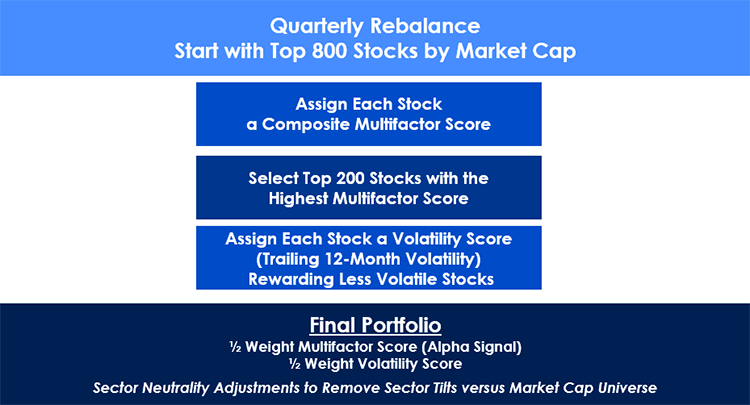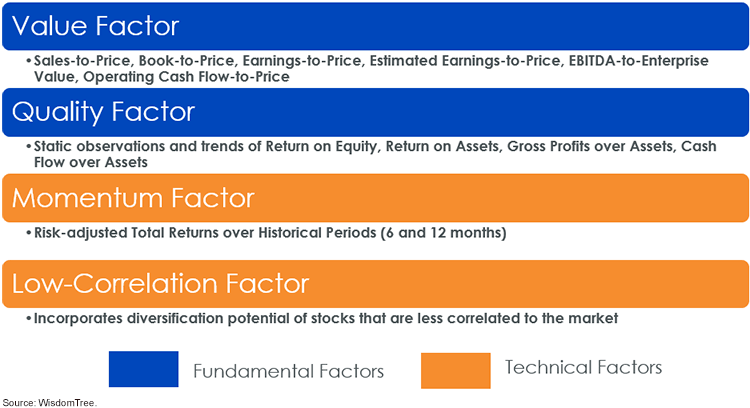Is USMF the ETF Industry’s Next Five-Tool Player?



In yesterday’s blog post, we discussed the background and rationale for launching the WisdomTree U.S. Multifactor Index—WisdomTree’s latest innovation in the quest for alpha with a diversified factor-investing process. WisdomTree’s U.S. Multifactor Index, which is tracked by the WisdomTree U.S. Multifactor Fund (USMF), is designed to provide greater potential for outperformance over standard beta indexes due to its greater stock selection risk and tracking error against beta, inherent in both its unique stock selection and its proprietary weighting methodology.
Innovations in this indexing approach include:
- Unique blending of fundamental and technical factors to create proprietary stock selection and weighting model.
- WisdomTree technical factor screens: momentum and low correlation
- Active Selection: WisdomTree selects stocks from a universe of the 800 largest market capitalization stocks in the United States. From this universe, WisdomTree selects the top 200 stocks with the highest combined factor score.
- Risk and Return Weighting: WisdomTree utilizes not just a stock’s factor score—its alpha signal—as part of the weighting process, but also its volatility level. Weighting by half of a stock’s factor score and half of its volatility score creates a risk-adjusted weighting system.
- Sector Neutrality: One of the key potential risks WisdomTree identified in factor investment strategies is how many such strategies wind up with large sector bets compared to the market. These sector bets may help or hurt over given market cycles, potentially causing the performance of one such strategy to have more to do with its sector exposures than its factor exposures. WisdomTree, in looking to add value through a diversified factor selection model, wanted to minimize the risk of diluting our alpha signals because of mismatched sector weights relative to the market.
Risk Reduction Methodology
One of the innovations in the WisdomTree factor approach was to incorporate a two-pronged volatility reduction strategy. Given that low volatility approaches have added to risk-adjusted returns over time, but not necessarily to absolute returns, we chose not to include it in our alpha-focused stock selection process.
Instead, WisdomTree incorporated a volatility-oriented weighting methodology to be applied to those stocks shown to have diversified factor alpha from exposure to value, quality, momentum and low correlation signals. We believe increasing exposure to lower-correlated parts of the market enhances diversification, and our research leads us to believe it can lower the overall volatility of our multifactor, alpha-driven strategy.
The WisdomTree multifactor methodology thus selects and weights constituents in an alpha-oriented manner, while also tilting those weights based on the overall volatility of each component—a Sharpe ratio weighting concept. Finally, because we depart from market cap weighting in weighting via our factor score and volatility scores, the Index naturally tilts toward more mid-cap exposure, thus giving the WisdomTree U.S. Multifactor Index exposure to the size factor.
The WisdomTree U.S. Multifactor Index can be summarized with this flow diagram:


Diversifying Factor-Specific Risk
A key benefit of using a multifactor stock selection methodology is the potential to diversify factor-specific risk. A natural question is: Why did we choose to score individual stocks based on our factor definitions rather than equally weighting the stocks selected for our distinct factor portfolios?
Our research found that by picking stocks based on one factor at a time, we diluted the alpha potential of various factor exposures when they were combined. To use a baseball analogy, rather than selecting the starting everyday lineup based on a players’ ability to excel in an individual area, we choose instead to search for "five-tool players”—those who can hit, hit with power, run, field and throw, in other words, the next Joe DiMaggio, Willie Mays or Roberto Clemente. Striking this balance helped us select 200 stocks that tapped into multiple factors, resulting in a basket more likely to outperform in various environments. We also believe that factors interact in ways one might not expect. For example, sometimes momentum acts best when applied to a value stock rather than as its own stand-alone screen. This might allow investors to avoid a value trap or hold a well-performing value stock longer, when it otherwise might have been rebalanced out of the portfolio as valuations rise.
Conclusion
Navigating today’s investment landscape can be difficult. Investors face many choices: between active and passive, mutual funds and exchange-traded funds (ETFs), and now beta and smart beta. WisdomTree believes it has tools that can help investors build a core smart beta position or, with this new Index and the ETF tracking it, a strategy that can replace traditional active managers.
With our initial dividend- or earnings-weighted methodologies, we have provided investors with broad diversified market exposure but have done so with a simple and intuitive twist: weighting equity markets by income. While this approach is now characterized as “smart,” it felt more like a clever way to gain beta exposure to the market, as opposed to an alpha-focused strategy centered on factor-based stock selection.
In the case of the WisdomTree U.S. Multifactor Index, we wanted to provide that same access to investors but now seek alpha more directly through focused factor exposure rather than just tilts. We did so in a sector-neutral manner, ensuring that the alpha generated comes from stock selection via factors rather than sector tilts. We included low correlation as a selection screen to potentially enhance returns and diversification, but incorporated low volatility into the weights we assign stocks at the quarterly rebalance. To us, this is the simple and intuitive solution to multifactor exposure, and one that, we hope, can serve investors when incorporated into their U.S. allocations over the long term. For investors interested in learning more about the ETF that tracks this Index, click on the WisdomTree U.S. Multifactor Fund (USMF).
Important Risks Related to this Article
There are risks associated with investing, including possible loss of principal. Investing in a Fund exposed to particular sectors increases the vulnerability to any single economic, political or regulatory development. This may result in greater share price volatility. Due to the investment strategy of the Fund, it may make higher capital gain distributions than other ETFs. Please read the Fund’s prospectus for specific details regarding the Fund’s risk profile.
Diversification does not eliminate the risk of experiencing investment losses.


Jeremy Schwartz has served as our Global Chief Investment Officer since November 2021 and leads WisdomTree’s investment strategy team in the construction of WisdomTree’s equity Indexes, quantitative active strategies and multi-asset Model Portfolios. Jeremy joined WisdomTree in May 2005 as a Senior Analyst, adding Deputy Director of Research to his responsibilities in February 2007. He served as Director of Research from October 2008 to October 2018 and as Global Head of Research from November 2018 to November 2021. Before joining WisdomTree, he was a head research assistant for Professor Jeremy Siegel and, in 2022, became his co-author on the sixth edition of the book Stocks for the Long Run. Jeremy is also co-author of the Financial Analysts Journal paper “What Happened to the Original Stocks in the S&P 500?” He received his B.S. in economics from The Wharton School of the University of Pennsylvania and hosts the Wharton Business Radio program Behind the Markets on SiriusXM 132. Jeremy is a member of the CFA Society of Philadelphia.

